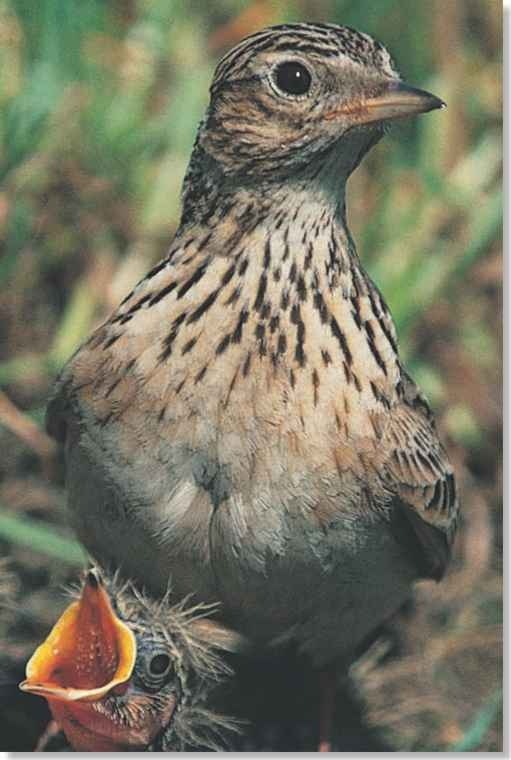ORDER
Passeriformes
FAMILY
Alaudidae
GENUS & SPECIES
KEY FEATURES
• A well-camouflaged bird of farmland and open country
I • Small in stature, but famous for its melodious, far-carrying song
• Sings while rising high into the sky and spiraling down to earth again
• Once very common, but threatened today by modern agriculture in many places
WHERE IN THE WORLD?
Native to Europe and northwestern Africa, and across northern
(Asia to China; northern populations migrate south in winter to the Mediterranean, the Middle East and central Asia
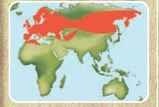
Lifecycle
The high, twittering song of the skylark evokes golden cornfields and summer days, inspiring naturalists and poets alike — but it can in fact be heard throughout the year.
Habitat
One of the most common farmland birds, the skylark also thrives in most kinds of open, treeless landscape. The species occurs everywhere from salt marshes and sand dunes to steppes and moors, avoiding only woods, high mountains and semideserts.
Individuals in the north and east of the breeding range fly south in the winter Skylarks in Scandinavia, for instance, leave for the fringes of the Mediterranean Sea in September, returning there to breed in early spring. The populations in southern Europe make more localized migrations to exploit seasonal food supplies.
Country retreat A ground-nesting bird, the skylark requires a habitat of seclusion.
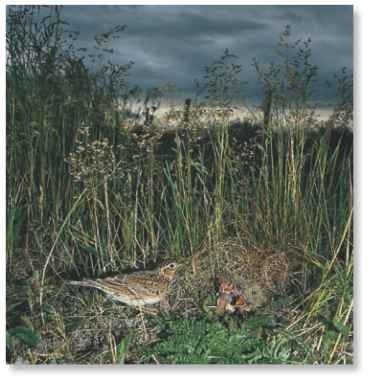
conservation
The skylark has been hit hard by changing farming practices. Pesticides kill its prey, and herbicides kill seed-bearing plants. Now that cereal crops are often sown in the autumn for harvesting in early summer — enabling farmers to grow another in midsummer — skylarks are deprived of winter fields of stubble.These are an important source of seeds, and in spring the crops have already grown too tall for the bird to make its nest.As a result, numbers have fallen in northwestern Europe. .
Behavior
The skylark’s main predators are weasels and foxes, as well as European sparrowhawks and harriers. When it senses danger; the skylark runs to cover or freezes on the spot, flattening its body against the ground. If the threat persists, the skylark “explodes” into the air without warning and flies to safety
In common with other species of the lark family, the skylark never bathes in streams or pools of water. The bird instead grooms by ruffling its plumage during showers of rain or by rolling about in dust and loose sand to remove parasites.

on a high note
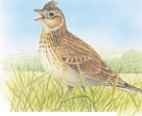
Ready for action…
A male skylark is about to perform a song flight and raises his crest in anticipation.
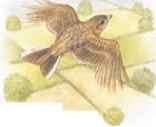
Point of view…
The lark climbs to a great height and hovers on the spot, all the while pouring out his sweet song.
Breeding
In late winter, the male skylark sings to proclaim territory and attract a mate. He devotes his energy to singing and chasing away rivals, and leaves the task of nest-building entirely to the female. She deposits her clutch of eggs in a shallow scrape in the soil and incubates them for two weeks. Both parents feed the chicks small insects.
Just over a week later, the flightless young leave the nest and embark on a dangerous stage. They spread out and continue to beg for meals from their parents, with only their camouflage for protection. After about ten days, the vulnerable youngsters make their first flights and become independent.The adult female immediately lays a new clutch in the same nest, and if conditions are right will later lay a third clutch.

A Safe and sound Parents walk to the nest to avoid betraying its location.
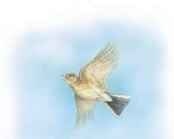
Up, up and away
About 30′ up, the lark switches from a slow, fluttering flight to a swift, vertical ascent.
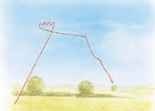
On course
Tracing patterns in the sky, the skylark plummets to the ground after about five minutes.
A favorite of Europeans, the skylark has been introduced in many areas of the world, including New Zealand, British Columbia and the Hawaiian Islands.
The skylark is an occasional mimic. It copies the songs of other larks and of waders, including the curlew and redshank.
Birds from the east of the skylark’s range are larger than those farther west; northerly breeders ‘ have longer wings to help them complete their migrations.
Food & feeding
The skylark is quick to take advantage of whatever food is most abundant. It forages on foot for a wide range of invertebrates, from spiders and earthworms to flies, caterpillars and beetles. The soft leaves of clover and other low-growing plants provide a welcome treat. Occasionally, the skylark becomes a nuisance to farmers by eating the succulent seedlings of lettuces, peas and sugar beet.
Animal prey becomes scarce in autumn, and the skylark survives on spilled grain and the seeds of weeds, such as thistles, chickweed, sorrel and mustard.The skvlark abandons its territories to father
in large flocks, often with buntings, finches and sparrows. Together, the small birds scour the land for seeds.
On the run
When feeding, the skylark relies on its mobility.
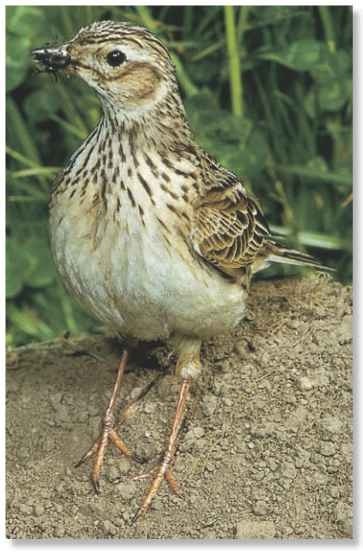
PROFILE
Skylark
With its streaky brown plumage and swift running speed, the skylark usually escapes notice until it takes to the air and bursts into song.
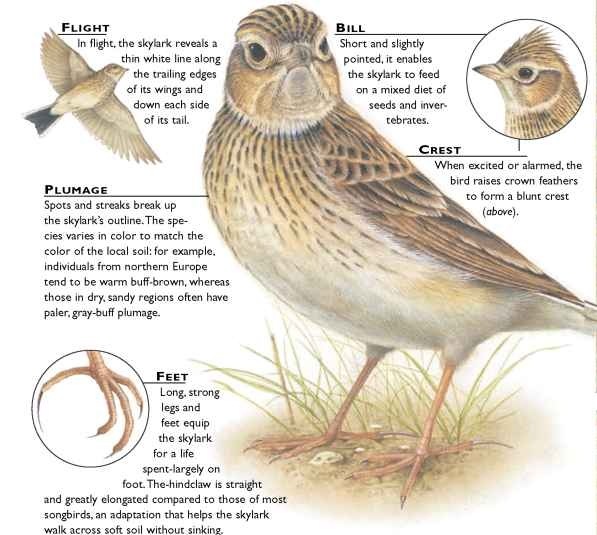
Creature comparisons
Nearly all species of lark have dull plumage in various shades of brown, gray, buff and white, but the horned lark (Eremophila alpestris) of northern latitudes is a
striking exception. It has almost unmarked white underparts, more evenly toned upperparts and bold, black-and-yellow head pattern.
In summer the horned lark is also adorned with a bizarre-looking pair of black feather tufts that sprout from just above and behind each eye — earning the bird its name. Despite its relatively showy plumage, however the horned lark can be as elusive as the skylark. It scurries quietly among grasses and lichen-covered boulders of tundra and grasslands of North America, Europe and Asia.
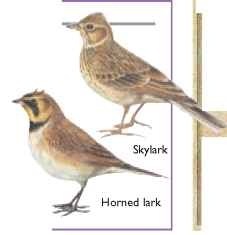
| VITAL STATISTICS | |
| Weight | 1-1.5 , |
| Length | 7-7.5″ |
| 1WlNGSPAN | 12-14″ |
| Sexual Maturity | 1 year |
| Breeding Season | March-August |
| Number of Eggs | 3-5 |
| Incubation 14 days Period | |
| Fledging Period | 18-20 days |
| Breeding Interval | 2 broods a year; rarely 3 |
| Typical Diet | Mainly insects in summer; seeds and grain in winter |
| Lifespan | Up to 8 years |
RELATED SPECIES
The skylark is 1 of species in the genus Alauda. The other species is the Oriental skylark, : A. gulgula. They are part of the Alaudidae family. This family has certain characteristics: the birds often have streaked or cryptic plumage; the hindclaw is straight and long, especially o in species living m soft soil; and nest! building is usually done by the female.
